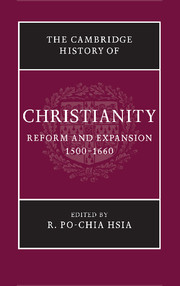Book contents
- Frontmatter
- Part I Luther and the Holy Roman Empire
- Part II The Second Reformation
- Part III Catholic Renewal
- 9 Redefining Catholicism: Trent and Beyond
- 10 New religious orders for men
- 11 Female sanctity, 1500–1660
- 12 Tridentine worship and the cult of saints
- Part IV Resolving Confessional Conflicts
- Part V Religion, Society, and Culture
- Part VI Christianity and Other Faiths
- Bibliography
- Index
- References
9 - Redefining Catholicism: Trent and Beyond
from Part III - Catholic Renewal
Published online by Cambridge University Press: 28 March 2008
- Frontmatter
- Part I Luther and the Holy Roman Empire
- Part II The Second Reformation
- Part III Catholic Renewal
- 9 Redefining Catholicism: Trent and Beyond
- 10 New religious orders for men
- 11 Female sanctity, 1500–1660
- 12 Tridentine worship and the cult of saints
- Part IV Resolving Confessional Conflicts
- Part V Religion, Society, and Culture
- Part VI Christianity and Other Faiths
- Bibliography
- Index
- References
Summary
About four o’clock on the afternoon of 4 December 1563, the 235 voting members of the Council of Trent processed from the Palazzo Thun across to the cathedral where the Bishop of Catania celebrated the Mass of the Holy Spirit. There followed a vote approving overwhelmingly the five reform decrees that had been formulated in the previous weeks. Next, the full text of the doctrinal decrees that the council had approved over the last eighteen years was read out, followed by the initial paragraphs of the reform decrees. The bishop then put two questions to the assembled fathers: were they agreed that the council be declared at an end and that confirmation of all its decrees be sought from Pope Pius IV in Rome? To the first the fathers reiterated the affirmative response given the previous day. Their similar response to the second question, with one dissenting vote, implied a clear recognition of papal authority and signified a notable victory for the papacy. To the unrestrained joy of the assembly, the council’s president, Cardinal Giovanni Morone, then declared the council ended. So the movement for reform and renewal within the Catholic Church reached a major milestone.
Historians have employed different terms over the years to designate sixteenth- and seventeenth-century Catholicism. ‘Counter-Reformation’ considered the developments within the Catholic Church to have been basically a reactionto the Protestant Reformation, and it evoked images of the Inquisition and the Index of Prohibited Books as well as the political and military measures of the religious wars. Many Catholics long countered this one-sided view with a similarly partisan position. They preferred ‘Catholic Reform’and argued that the church had begun the necessary process of reform long before 1517.
- Type
- Chapter
- Information
- The Cambridge History of Christianity , pp. 143 - 161Publisher: Cambridge University PressPrint publication year: 2007
References
- 3
- Cited by

